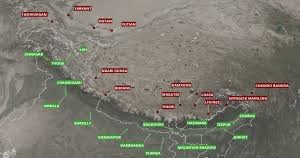Made youth aware of India’s Vision @2047 and their role in its achievement.
At the Chatra Sansad, Gujarat 2025.
India Vision 2047 (also referred to as Viksit Bharat @2047) is a strategic blueprint initiated by the Indian government, led by NITI Aayog, to transform India into a developed nation with a USD 30 trillion economy and a per capita income of USD 18,000–20,000 by 2047, marking the centenary of India’s independence. The vision aims to ensure sustainable, inclusive growth while avoiding the middle-income trap that has stalled progress in other nations.
The youth of India, constituting over 40% of the population under 25 years and a significant portion of the 1.12 billion working-age population by 2047, are pivotal to realising India Vision 2047 (Viksit Bharat @2047). Their energy, innovation, and demographic dividend position them as key drivers in transforming India.
India Vision 2047: Key Objectives
Developed India
- Transition from a developing to a developed nation.
- Targeting a $30 trillion economy, up from $3.7 trillion in 2025.
- Strong manufacturing base under Make in India, with high-tech
- Global leadership in IT, space, green energy, and AI sectors.
Inclusive and Equitable Growth
- Universal access to quality education, healthcare, housing, and digital connectivity.
- Bridging rural-urban divides and reducing income inequality.
- Empowering women and marginalised communities.
Technological Leadership
- AI, quantum computing, 6G, biotech, and cyber defence.
- Indigenous R&D with global patents and innovations.
- National digital infrastructure and digital governance.
Strategic and Geopolitical Leadership
- Stronger military capabilities (e.g., modernisation, self-reliance via Atmanirbhar Bharat).
- Strategic autonomy in foreign policy.
- Expanded global influence: Permanent UN Security Council seat, active G20 leadership, South-South cooperation.
Vision Targets
Economic Growth
- Achieve a USD 30 trillion economy, making India one of the world’s largest economies (potentially surpassing Japan and Germany by 2030).
- Sustain an annual GDP growth rate of approximately 7–9% from 2030 to 2047, with projections of 9.2% (2030–2040) and 8.8% (2040–2047).
- Increase per capita income from USD 2,392 (2023) to USD 18,000–20,000 by 2047.
- Boost exports to USD 8.67 trillion and imports to USD 12.12 trillion by 2047.
- Expand the middle class from 50 million (2023) to over 500 million by 2050, driving domestic demand.
Infrastructure Development
- Build world-class infrastructure in urban and rural areas, ensuring equitable access to clean water, electricity, and healthcare.
- Prepare urban systems for nearly 50% of the city population by 2047, with improved services and balanced regional development.
- Develop “future-ready” urban spaces and modernise rural infrastructure, including micro-irrigation and organic farming in agriculture.
Social Development
- Raise average life expectancy to 71.8 (from 67.2 in 2021) and achieve a literacy rate of 89.8% (from 77.8% in 2021).
- Aim for universal literacy (100%) and significantly reduce infant mortality by 2047.
- Increase female labour force participation from 37% to over 70%.
- Leverage India’s demographic dividend, with over 40% of the population below 25 years and a working-age population of approximately 1.12 billion by 2047.
Sustainability and Climate Resilience
- Reduce carbon emission intensity by 55% from 2005 to 2047, aligning with India’s net-zero target by 2070.
- Promote green technologies, renewable energy, and climate-resilient agriculture to ensure sustainable development.
- Enhance weather-readiness and climate resilience through inter-ministerial collaboration, AI-driven predictions, and digital twins for disaster management.
Governance and Global Engagement
- Minimise government interference in citizens’ lives and streamline processes through re-engineering and digital transformation.
- Position India as a global leader in trade, investment, technology, and innovation. Indian firms dominate sectors like IT, pharmaceuticals, and manufacturing.
- Foster global champions by restructuring public sector enterprises and creating 3–4 major players in key sectors (e.g., banking, oil, semiconductors).
- Strengthen geopolitical influence, positioning India as a “peacemaker of last resort” and a hub for friend-sourcing trade.
Core Strategies
Demography, Democracy, Diversity. Leverage India’s young population, vibrant democracy, and cultural diversity as foundational pillars for growth.
Sectoral Focus. Prioritise 10 key sectors: agriculture, infrastructure, technology, governance, health, education, commerce, industry, security, and foreign affairs.
Avoiding the Middle-Income Trap. To ensure sustained growth, implement structural reforms, enhance competitiveness, and address regional disparities.
Human Capital Development. To create a skilled workforce, education and skilling must be aligned with global demands (e.g., nursing, IT, Industry 4.0 technologies).
Inclusive Growth. Ensure balanced development across regions, focusing on lagging areas in the East and North, and empower women through workforce participation.
Industry and Innovation. Increase manufacturing’s GDP share from 15% to 25%, localise innovation, and aim for a 12% global manufacturing share (from 3.1%).
Participative Governance. Promote “Sabka Saath, Sabka Vikas, Sabka Vishwas, Sabka Prayas” (Together with all, Development for all, Trust of all, Efforts of all) to foster collective action.
Implementation Framework
Timeline. The plan outlines milestones for 2030 (short-term) and 2047 (long-term), with actionable reforms and outcomes.
Stakeholder Collaboration. Involves ministries, states, the private sector, research institutions, and global experts.
Role of States. States like Gujarat, Andhra Pradesh, Uttar Pradesh, and Tamil Nadu are aligning their vision documents with the national plan.
Sectoral Groups of Secretaries (SGoS). Ten groups were formed in December 2021 to create roadmaps for key sectors, with targets set for this decade as the foundation for 2047 goals.
Monitoring and Evaluation. Regular reviews, gap analysis, and stress testing to ensure progress and resilience, especially in disaster management.
Challenges
- Tackling unemployment and skilling for future jobs.
- Navigating global economic uncertainties.
- Federal coordination across states and central agencies.
- Balancing growth with environmental commitments.
Economic Hurdles
- Sustaining high growth amidst global economic uncertainties and a projected trade deficit of over USD 3 trillion by 2047.
- Managing the rupee-dollar exchange rate, which impacts GDP in dollar terms.
- Balancing fiscal consolidation with high capital expenditure to avoid restricting government interventions.
Sectoral Stagnation
- Revitalising agriculture (17% of GDP, employs 50% of workforce) and manufacturing (15% of GDP) to boost productivity and employment.
- Addressing supply chain vulnerabilities and reducing reliance on imports through Production-Linked Incentives (PLI) schemes.
- Regional Disparities. Bridging the development gap between the West/South and East/North to ensure inclusive growth.
- Geopolitical Risks. Navigating tensions with neighbours (e.g., China, Pakistan) and global trade restrictions, such as U.S. tariffs.
- Climate Vulnerabilities. Managing climate impacts on agriculture, water resources, and coastal ecosystems is challenging, as over 60% of farmers depend on rain.
- Scepticism on Execution. Some critics highlight a gap between ambitious goals and ground-level implementation, with concerns about persistent poverty and inequality.
Driving Change: Youth as Architects of India’s Vision 2047
The youth of India, constituting over 40% of the population under 25 years and a significant portion of the 1.12 billion working-age population by 2047, are pivotal to realising India Vision 2047 (Viksit Bharat @2047). Their energy, innovation, and demographic dividend position them as key drivers in transforming India. Suggestions for youth participation are as follows:-
- Pursue STEM education, vocational training, and entrepreneurial ventures; advocate for gender equality in workplaces; engage in gig and digital economies to enhance productivity.
- Participate in hackathons, research fellowships, and tech incubators; develop sustainability-focused startups; collaborate with global institutions to innovate in high-tech sectors.
- Volunteer in literacy and health outreach programs; use social media to raise awareness about equity; mentor underprivileged peers to access education and opportunities.
- Join environmental NGOs; adopt sustainable practices (e.g., reducing waste, using public transport); innovate in green tech startups or research climate solutions.
- Participate in youth parliaments, policy forums, and online consultations; use platforms like X to discuss governance issues; volunteer in community governance projects.
- Represent India in international forums, create content showcasing Indian culture, and network with global Indian communities to foster trade and innovation.
- Demand policy reforms for job creation; support peers from underserved communities; engage in geopolitical studies to understand global dynamics.
Conclusion
India Vision 2047 is an ambitious roadmap to transform India into a global powerhouse by its 100th year of independence. Anchored in economic growth, sustainability, and inclusive development, it leverages India’s demographic, democratic, and diverse strengths. While the vision is comprehensive, its success hinges on execution. However, overcoming structural challenges, ensuring effective implementation, and adapting to global uncertainties will be key to realising this vision.
The youth are the torchbearers of India Vision 2047, driving economic growth, innovation, sustainability, and social progress. By leveraging their skills, creativity, and global outlook, they can transform India into a developed, inclusive, and influential nation by 2047. Their active participation in education, entrepreneurship, governance, and climate action, supported by government and private initiatives, will determine the vision’s success.
Please Add Value to the write-up with your views on the subject.
For regular updates, please register your email here:-
References and credits
To all the online sites and channels.
Pics Courtesy: Internet
Disclaimer:
Information and data included in the blog are for educational & non-commercial purposes only and have been carefully adapted, excerpted, or edited from reliable and accurate sources. All copyrighted material belongs to the respective owners and is provided only for wider dissemination.
Bibliography
- Chavan, P. (2024). Viksit Bharat @2047: Pathways to a developed India. ResearchGate.
- Drishti IAS. (2025, January 23). Vision India@2047: Transforming the nation’s future. Drishti IAS.
- Government of India. (2023, December 11). PM launches ‘Viksit Bharat @2047: Voice of Youth’. Press Information Bureau.
- Grant Thornton Bharat. (2024, September 23). Towards a Viksit Bharat: Building inclusive and sustainable infrastructure for India’s future. Grant Thornton.
- Gupta, S., & Sachdeva, R. (2025). Decoding state growth: India’s path to a developed nation by 2047. Centre for Social and Economic Progress (CSEP).
- India. (2024, July 26). Essay on Viksit Bharat: A vision for a developed India. IndiaCSR.
- NITI Aayog. (2023). Vision India@2047: Preliminary forecasting results. NITI Aayog.
- PWOnlyIAS. (2023, December 28). Vision 2047: A roadmap to a $30 trillion economy. PWOnlyIAS.
- REPL. (n.d.). India’s Vision 2047 for sustainable development. REPL Global.
- Singh, C. (2025, February 9). How can India rapidly grow to achieve the ‘Viksit Bharat 2047’ goal? Business Standard.
- Subrahmanyam, K. V. (2023, October 30). Vision document to make India a $30 trillion economy by 2047 in the final stages. The Indian Express.
- Vajiram & Ravi. (2023, October 31). The Vision India@2047: India will become a $30-trillion economy by 2047. Vajiram & Ravi.



